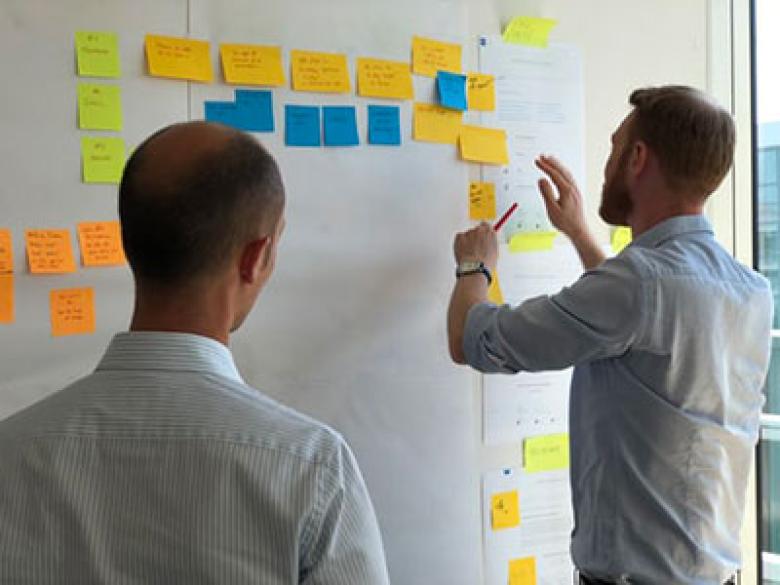5. Sneaky bonus step: retro
So, we know we said you only needed four pieces, but this fifth one closes the loop that you started when you planned your sprint – the retro.
Retro, as jargon goes, is just a shortening of ‘retrospective’ (but feel free to wear flares).
The retro should happen at the end of the sprint, and you should take a look at your board and see how you went.
Ask the following questions:
- Did we complete all the tasks that we needed to during the week?
- What went well?
- What didn’t go well?
- What does that mean?
- What can you do about it?
A proper explanation of a retro needs its own proper explainer, but for this purpose, you’re trying to work out how you’ve worked, and what you can do to make that better.
Also, be honest here. If there were things getting in the way of these tasks, that’s legit. If those things include motivation, means-of-production or mental health, that’s legit. This process can be a really helpful way for managers to, well, manage their team’s work, and recognise gaps in skills, resourcing, knowledge, whatever it is.
After you’ve done your retro, pack everything away and go home. Then start back at the sprint planning, where you look at your backlog and move things across to the next sprint.
See? Easy.
Glossary
Agile
A project management methodology that organises work into short bursts (sprints) so that changes can be made according to what has been learnt in those short bursts. ‘Agile’ and ‘agility’ can also describe how an organisation/team is able to change quickly. For clarity, we use a capitalised, proper noun ‘Agile’ to describe the project management methodology.
Backlog
The backlog of tasks that has to happen. This one’s pretty straightforward actually.
Daily stand-up
Should really be called a ‘daily stand-up meeting’. It’s a meeting, that happens daily, and you stand to keep it short and snappy.
Kanban
A variant of Agile aimed at continuous improvement of ongoing work, as opposed to discrete projects. For discrete projects, see Scrum.
Kanban boards
A visual board that organises the tasks you have to do. Sometimes people use ‘Kanban’ as a noun to describe the boards, like ‘Everyone on level 9 must make sure their kanbans are taken down because the windows are going to be cleaned’. This is technically wrong but y’know, language is fluid.
Minimum Viable Product (MVP)
An MVP is the version of a thing (project work, software release, tea-bun) that is just good enough to put out in the world. You put out the just-good-enough version to learn how people use it, what could be better, then you make those changes in the next sprint. That’s basically Agile in a nutshell.
Niko-niko calendar
Actually, this name is completely new to us, but we’ve done the practice before: You make a calendar that tracks how people are going. From there, you can look for patterns to hopefully make life better for members of your team. Plus, Niko-niko is an excellent name.
Planning poker (also known as Scrum poker)
Assigning scores to tasks based on how long something will take or how difficult it will be. You sit in a circle with cards that have numbers on them. The person leading the meeting points to a task and everyone plays a card with the number they think the task is worth. It sounds slightly bonkers, but is actually probably the most valuable advanced Agile move you can do.
Retro
Short for ‘retrospective’. A meeting that looks back at a chunk of work and works out how it went and what could be done better next time. (There are a variety of variations of retros, try to find the one that best fits what you need.)
Scrum
A variant of Agile aimed at discrete projects, as opposed to continuous improvement of ongoing work. For ongoing work, see Kanban. Also, this term was put in place in a place in the world that doesn’t play a lot of rugby, but comes from people looking at a stand-up meeting and thinking, hey, that’s kind of like a scrum. As any second rower who is also a Scrum Master can tell you, it’s not (though we’re kinda into the idea of two teams having competing stand-up meetings). For clarity, again, use the capital, proper noun for Scrum to avoid people thinking you’re having a laugh.
Scrum board
Like a Kanban board but for the Scrum style of Agile.
Scrum Master
The person who runs the stand-ups. This name seems to come across even if you’re doing Kanban work (it’s very rare to hear of a Kanban Master). Not a name for the half-back/scrum-half.
Sprint
A short period of time over which a certain amount of work will be done. Almost always 1 week or 2 weeks.
Sprint plan
A meeting that happens at the start of a sprint where you decide what will be in the sprint. Sort of the opposite to a retro.
Task board
A generic term for a Kanban or Scrum board. Never actually heard someone use this, but it makes sense.
Timebox
Literally a fancy word for setting a timer. If you ‘timebox’ something you say that thing can’t go beyond when the timer stops.
See also
The Public Sector Innovation Network (PSIN) was an Australian government network helping public servants understand and apply innovation in their daily work. PSIN ceased on 8 January 2021.
See more PSIN resources or read about PSIN on the National Library of Australia Trove archive.





